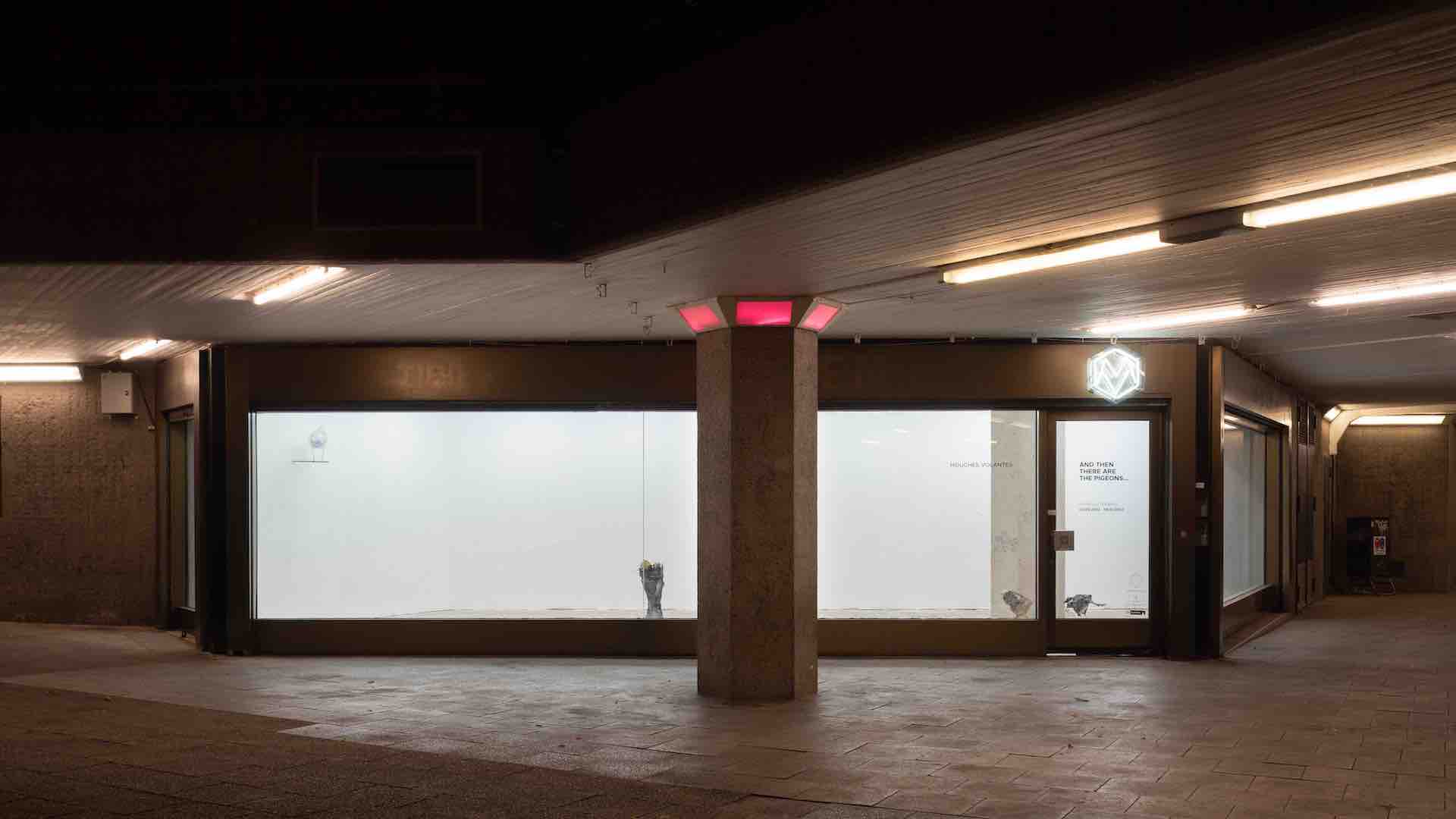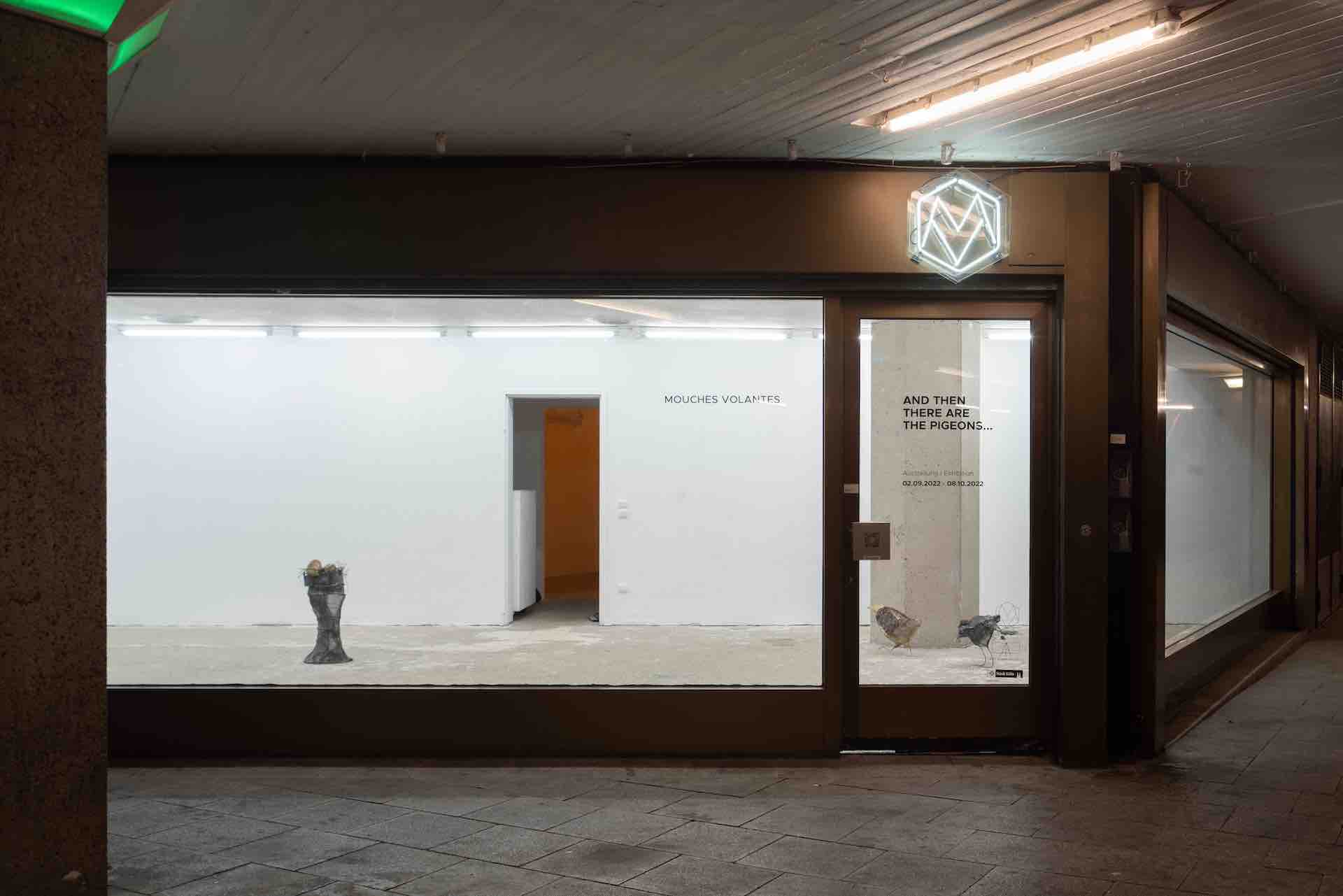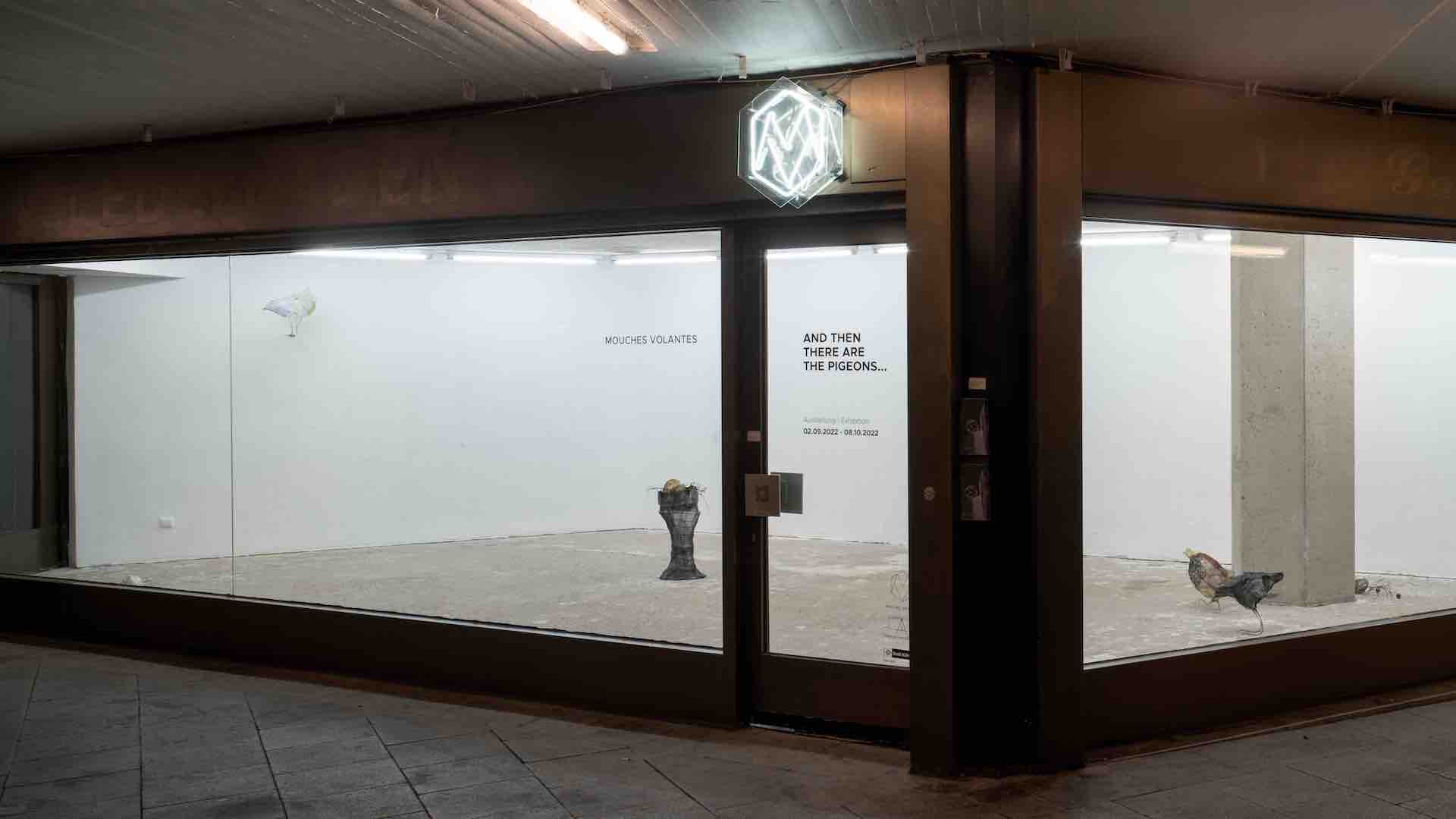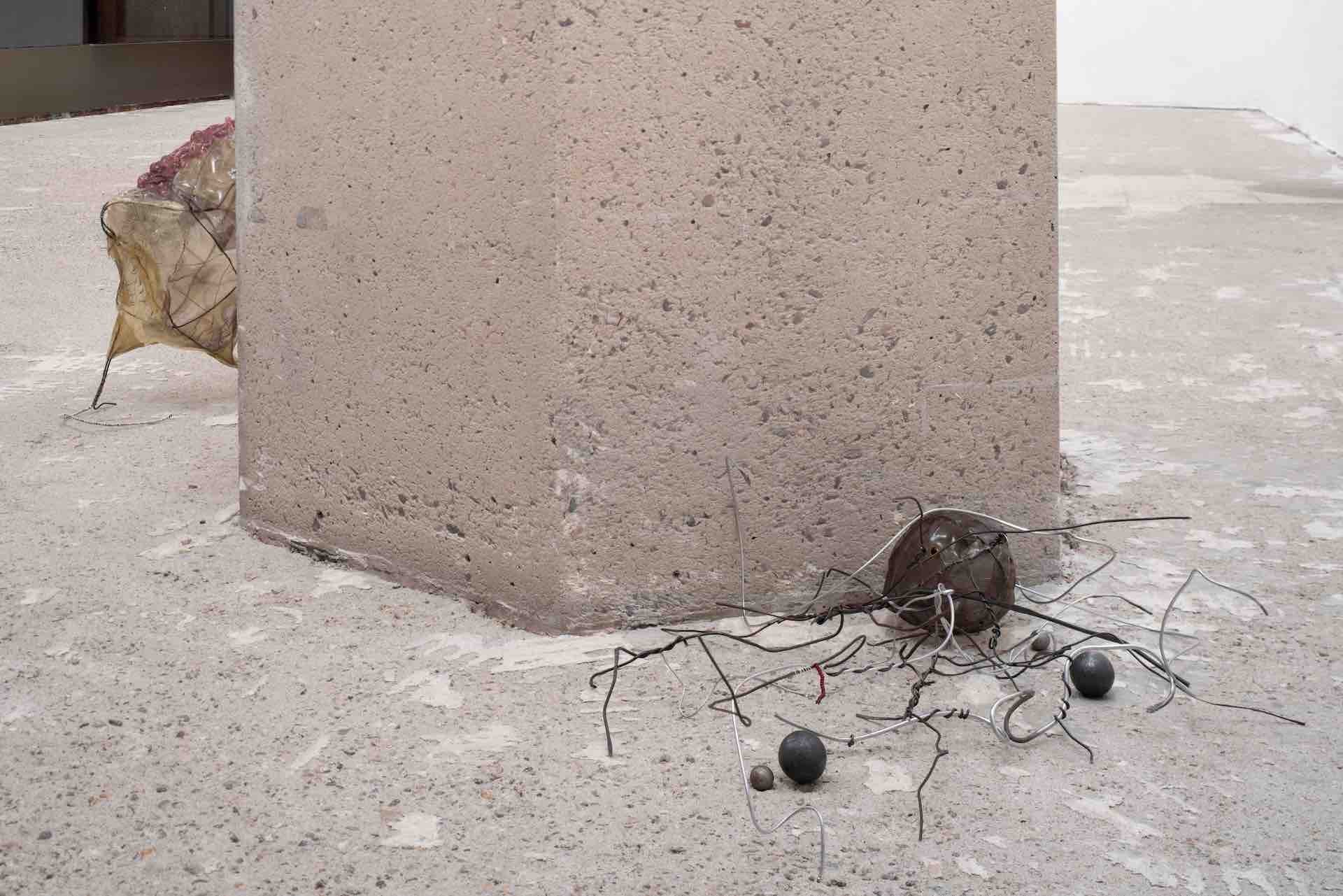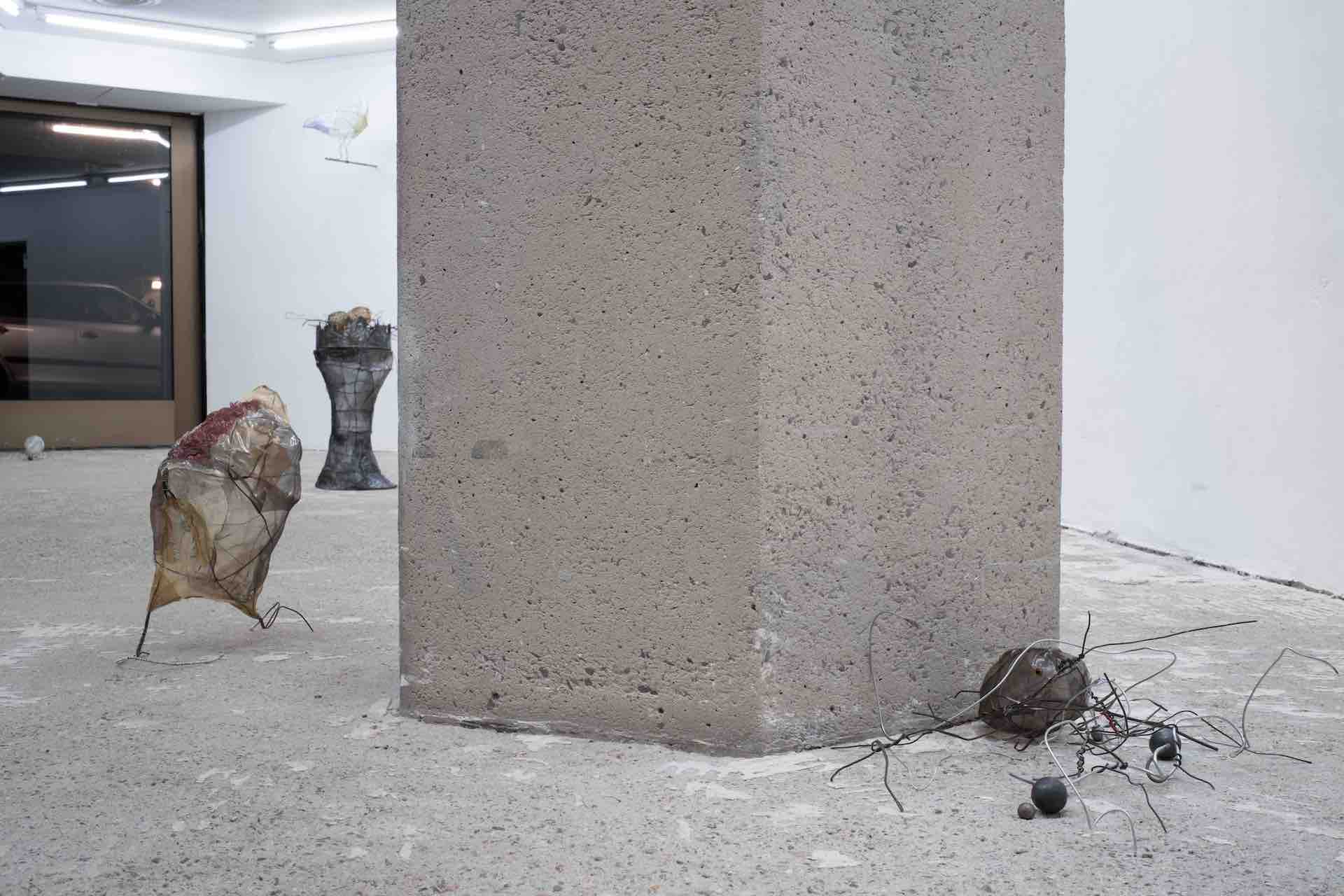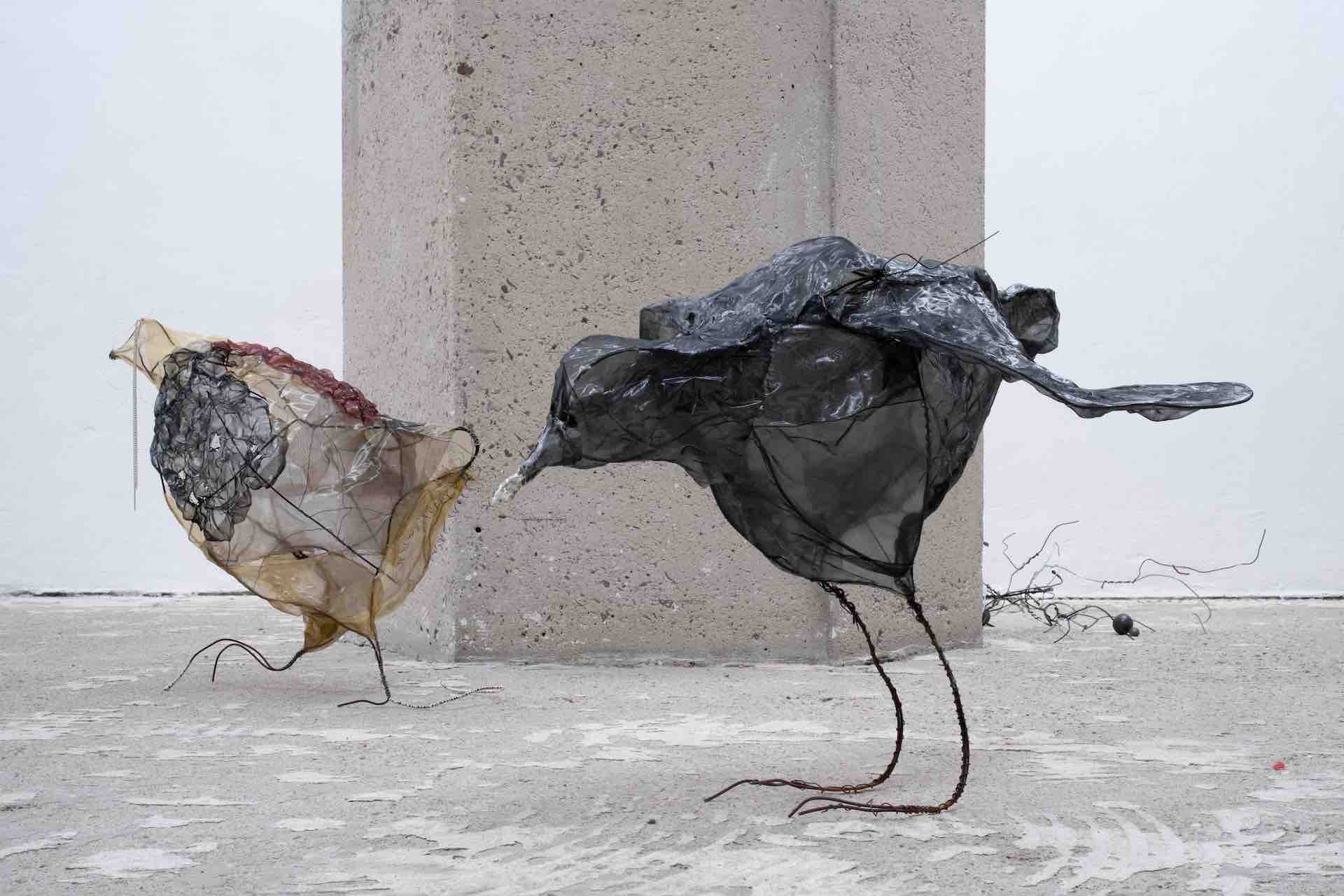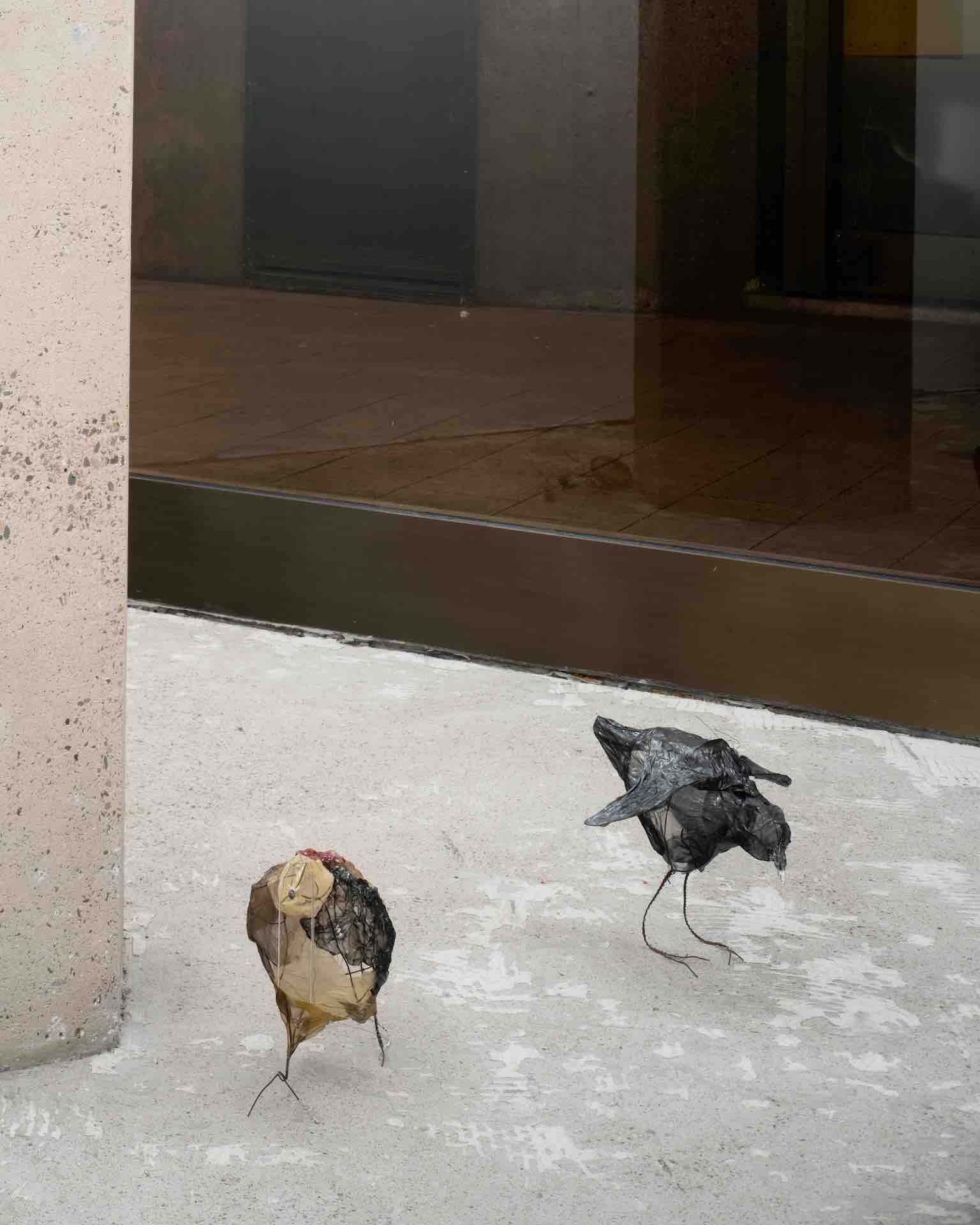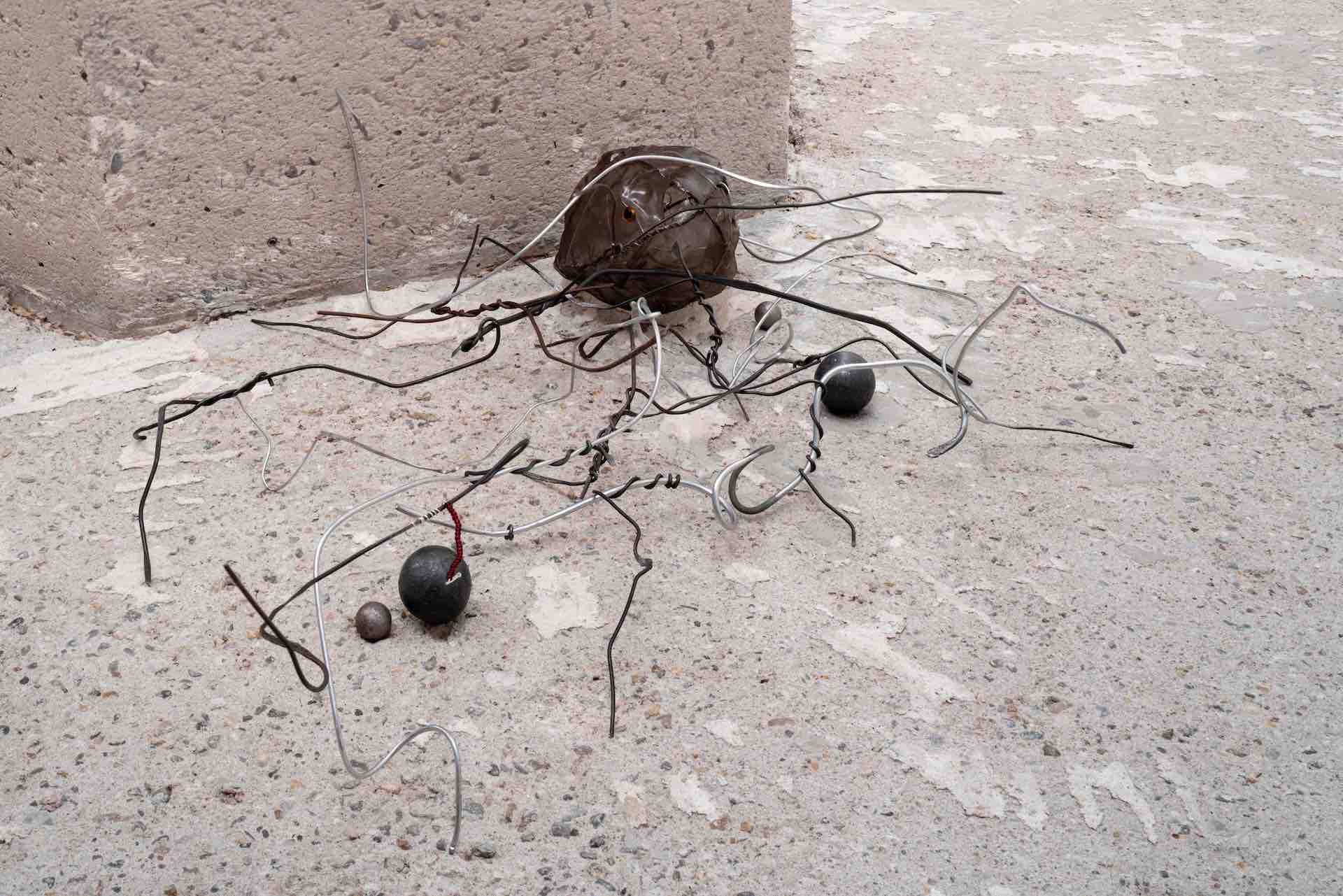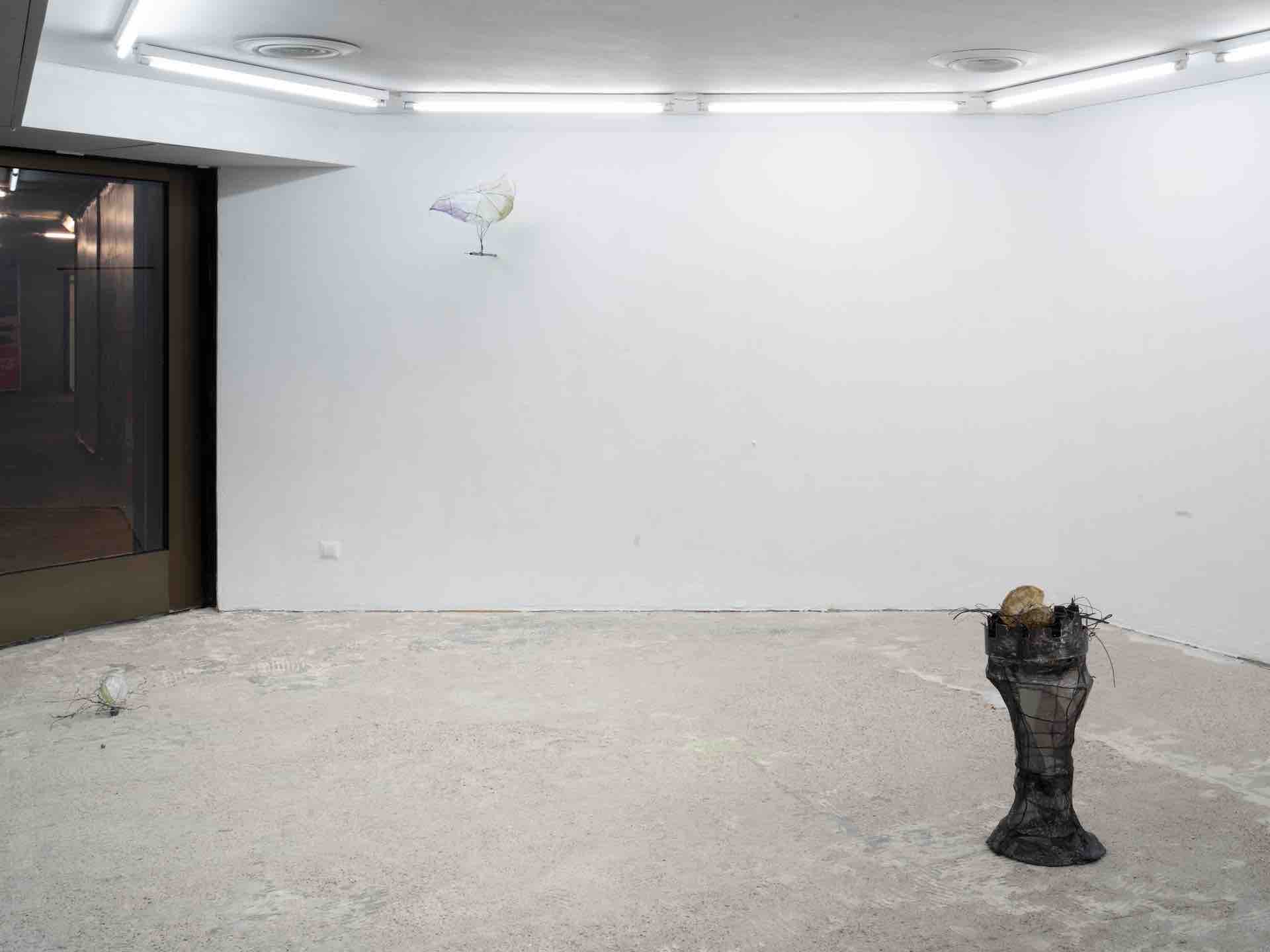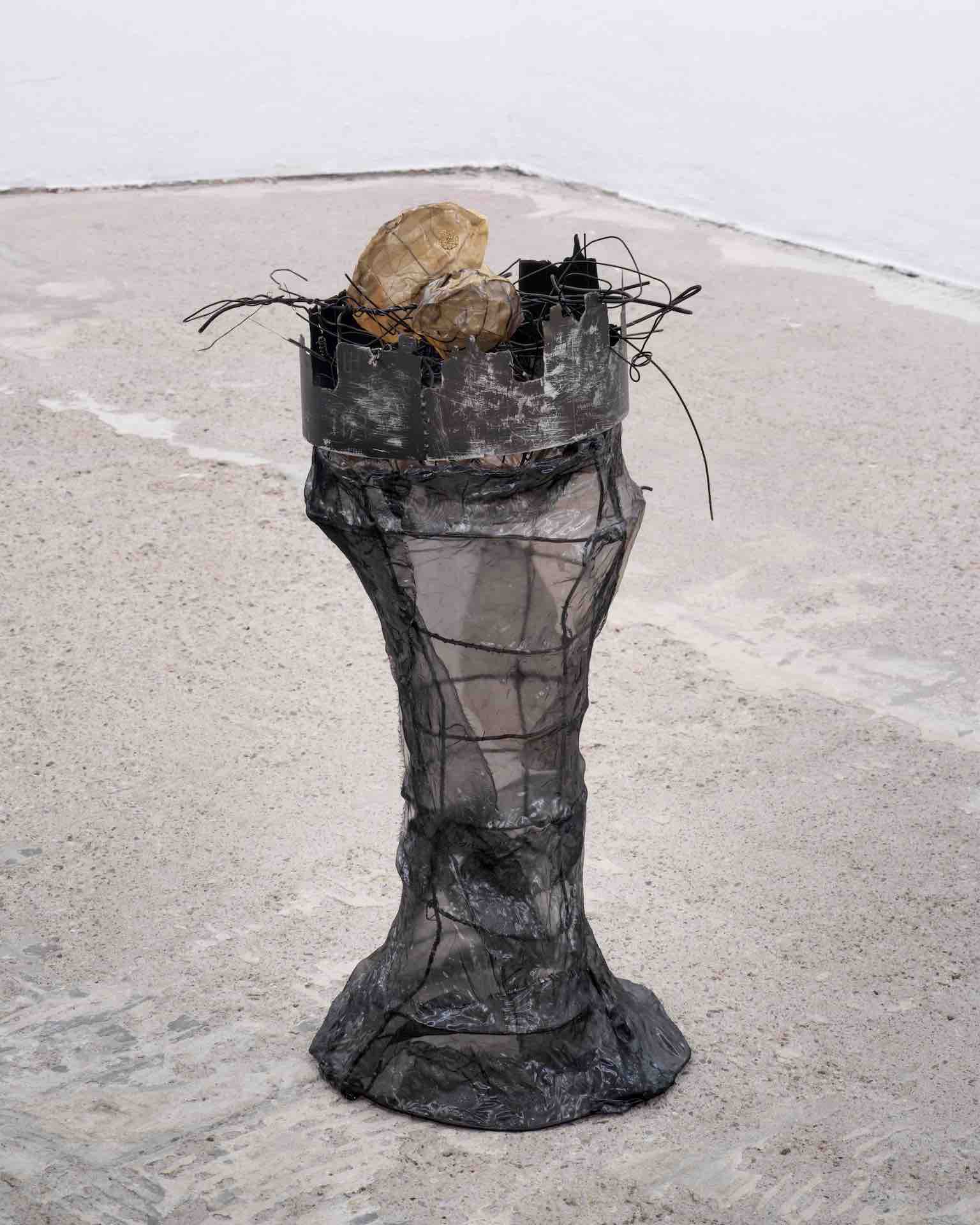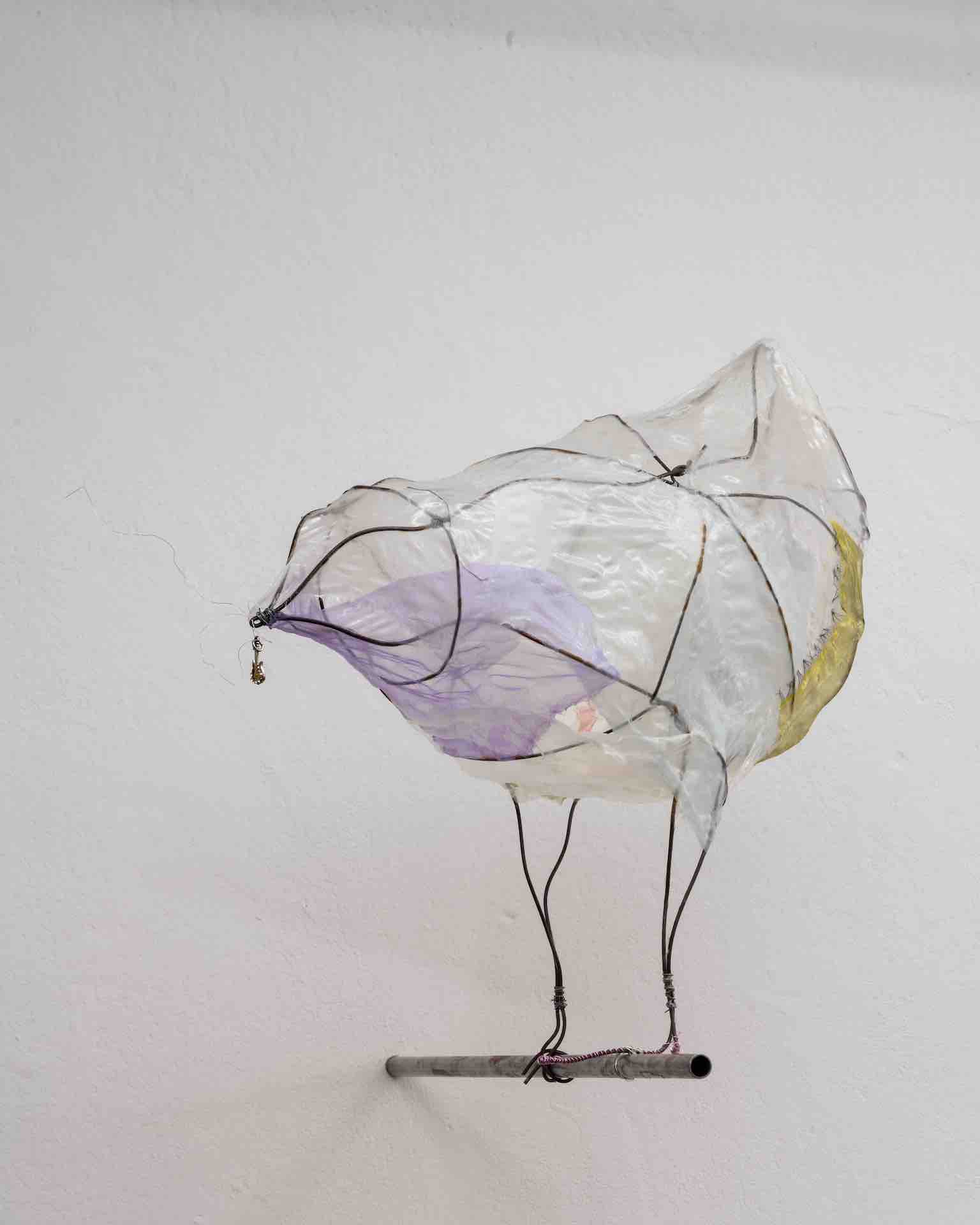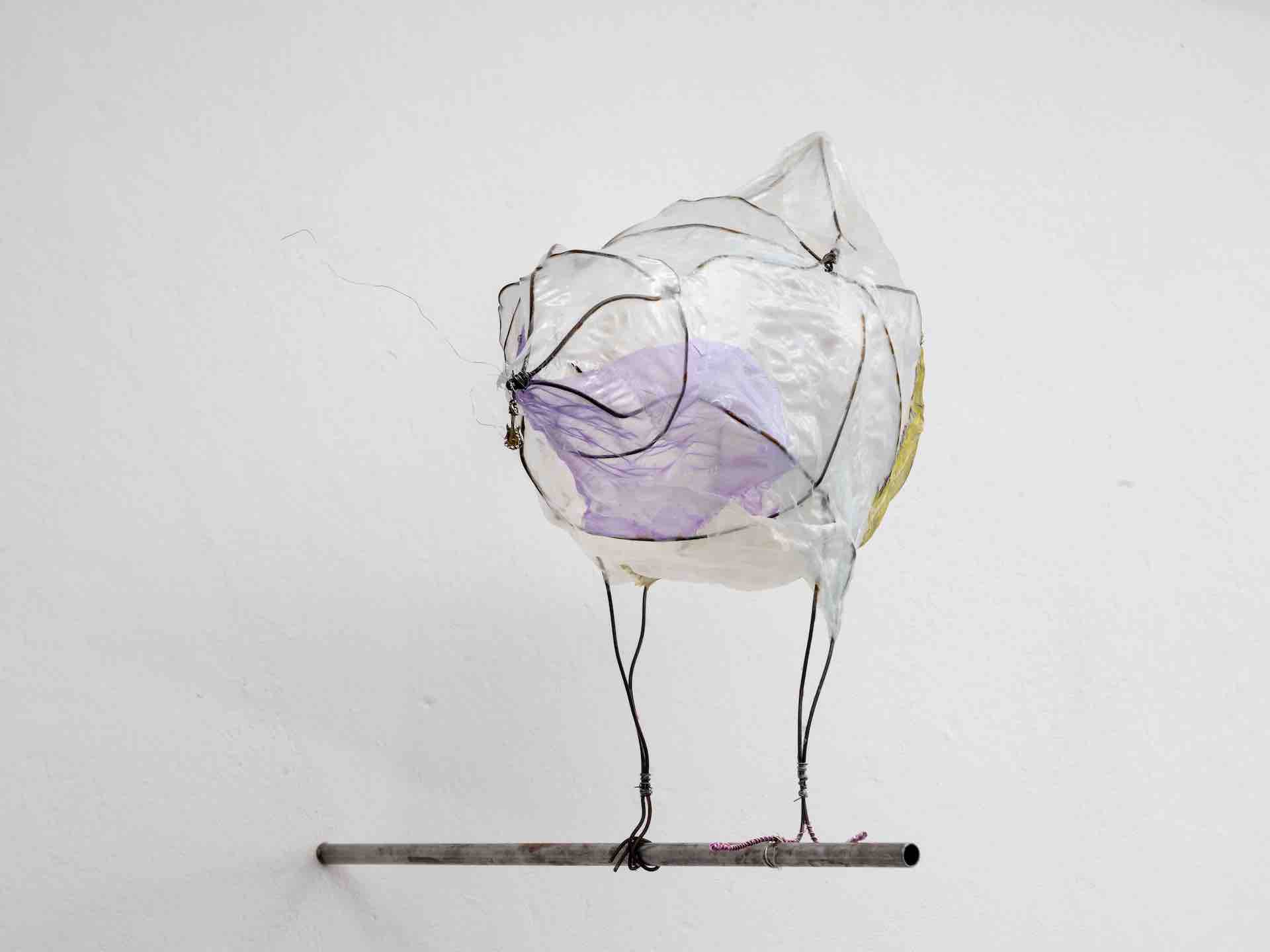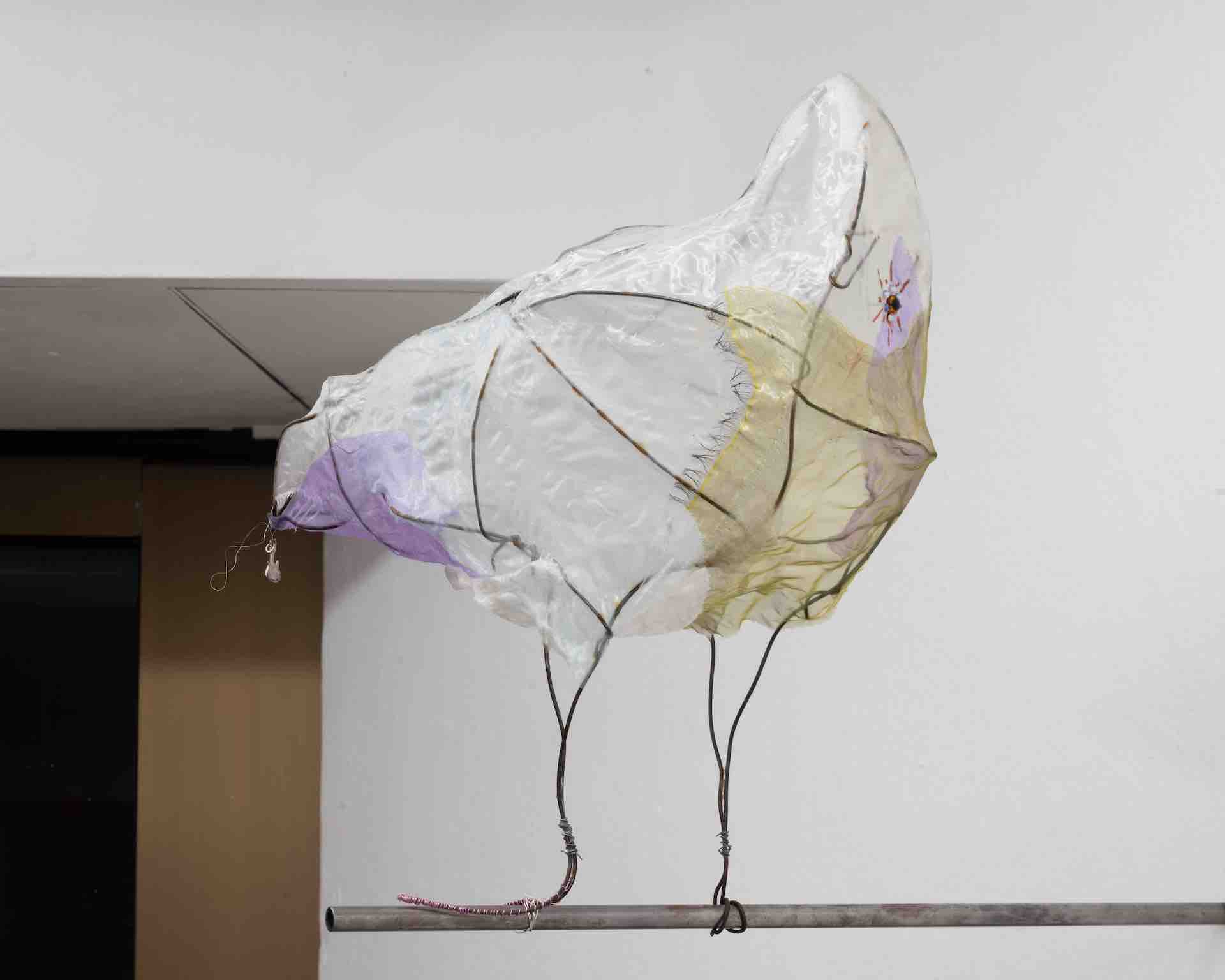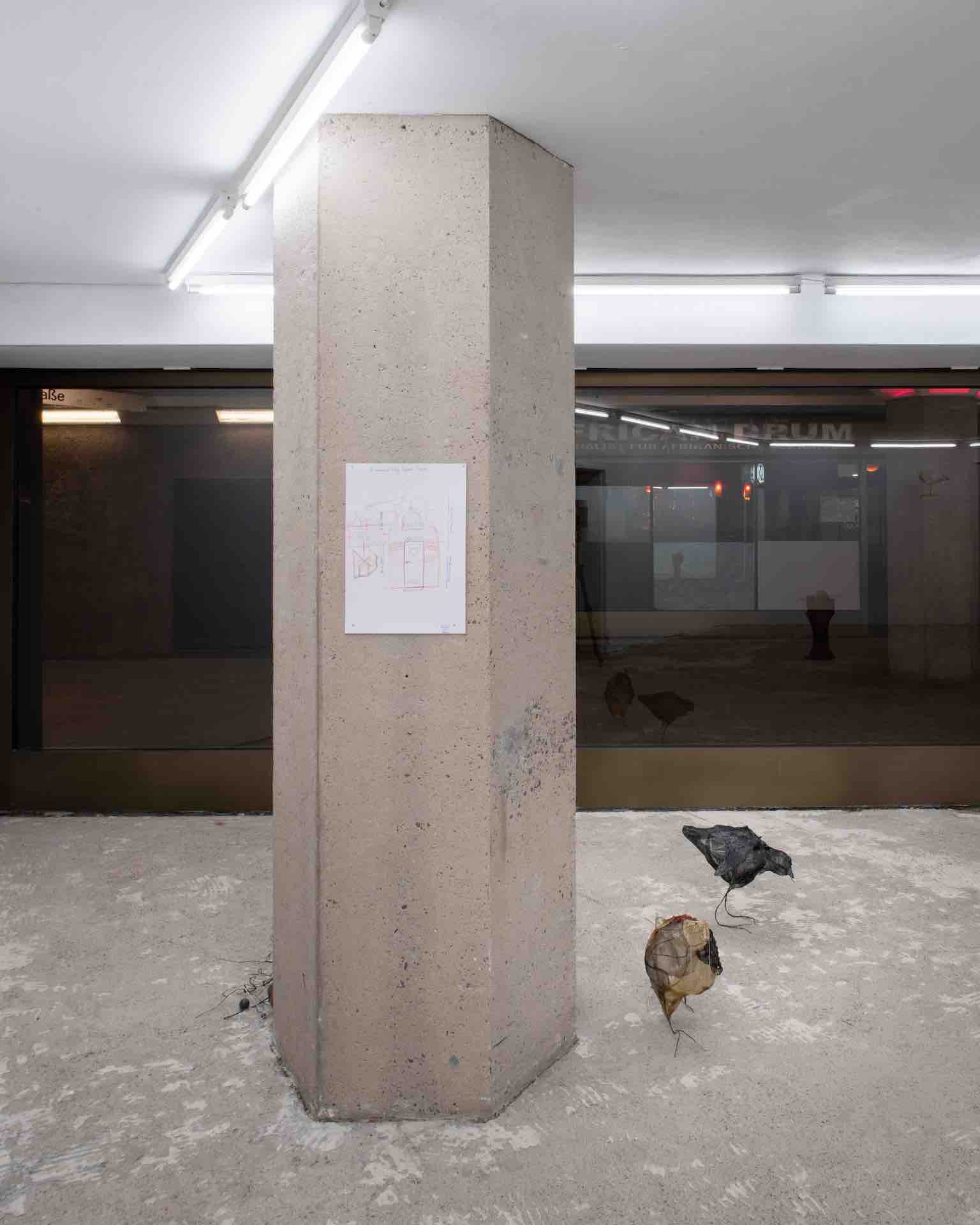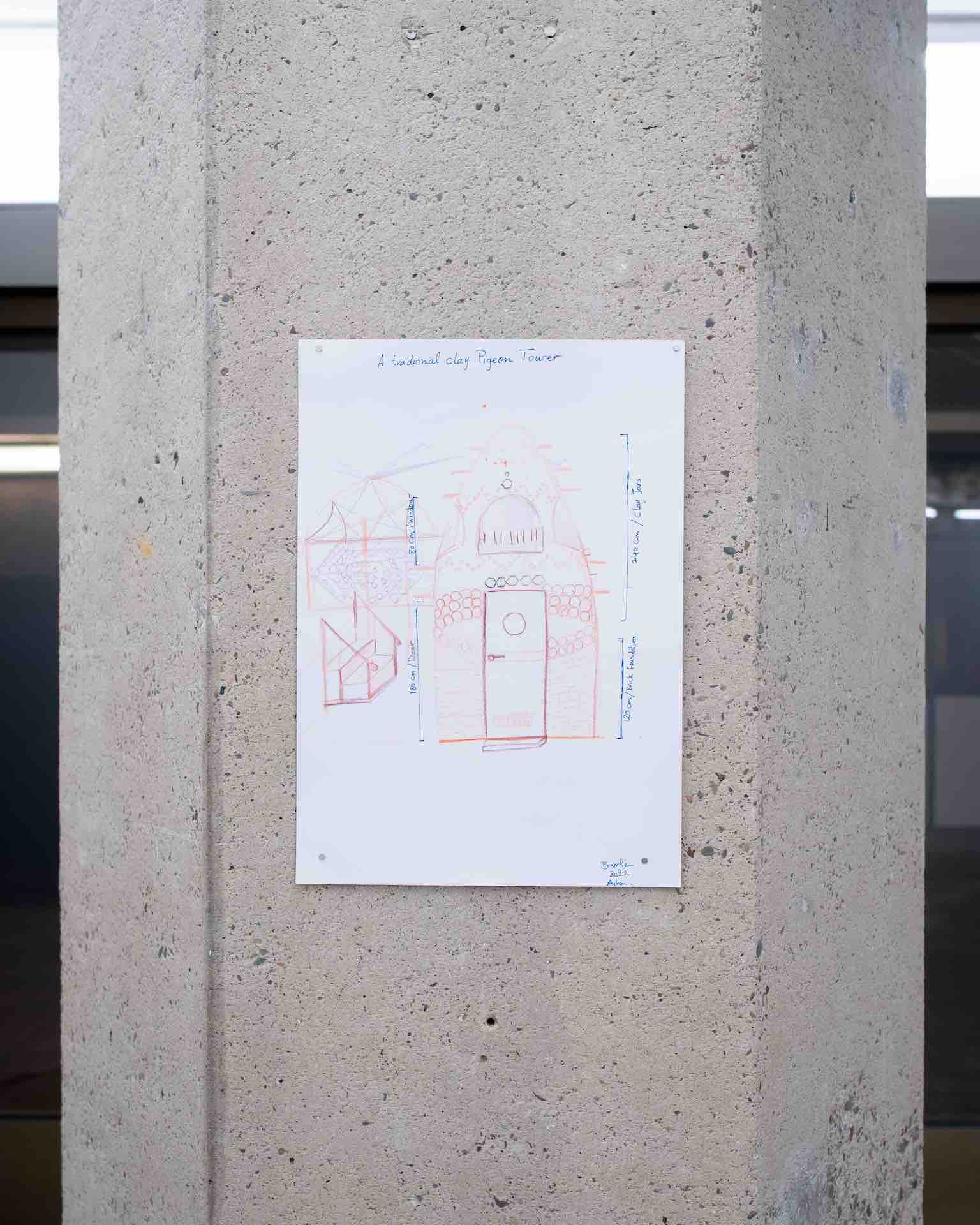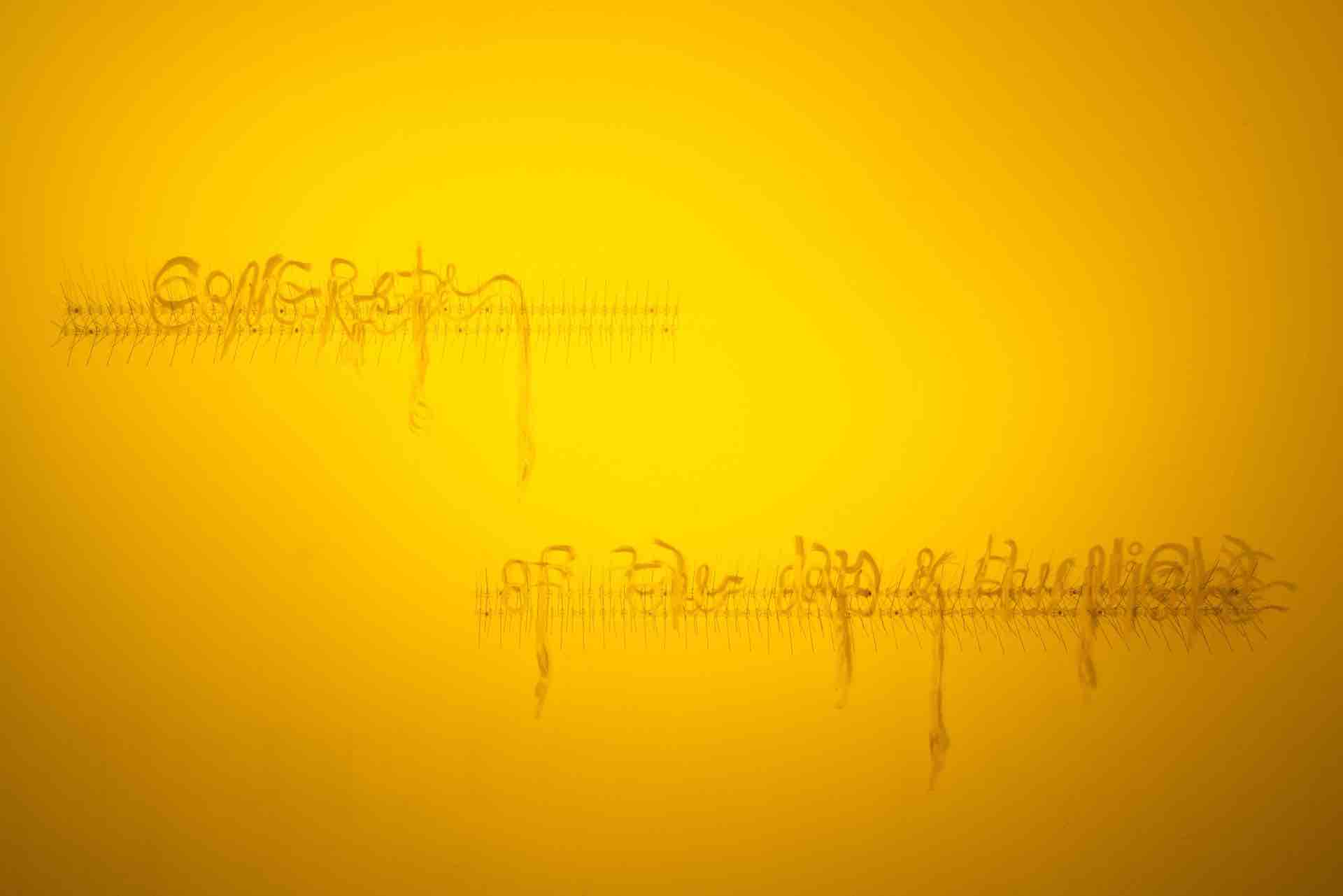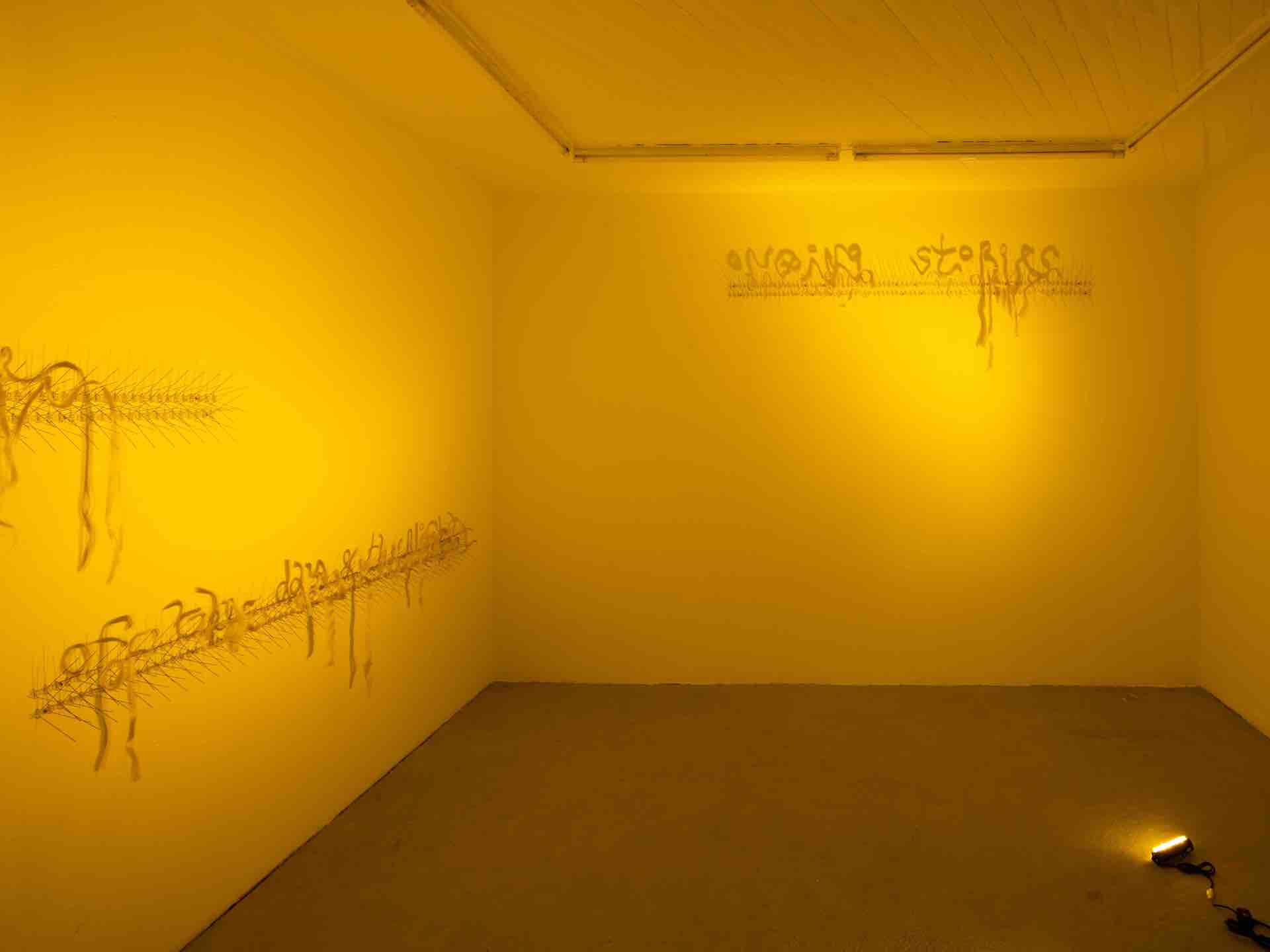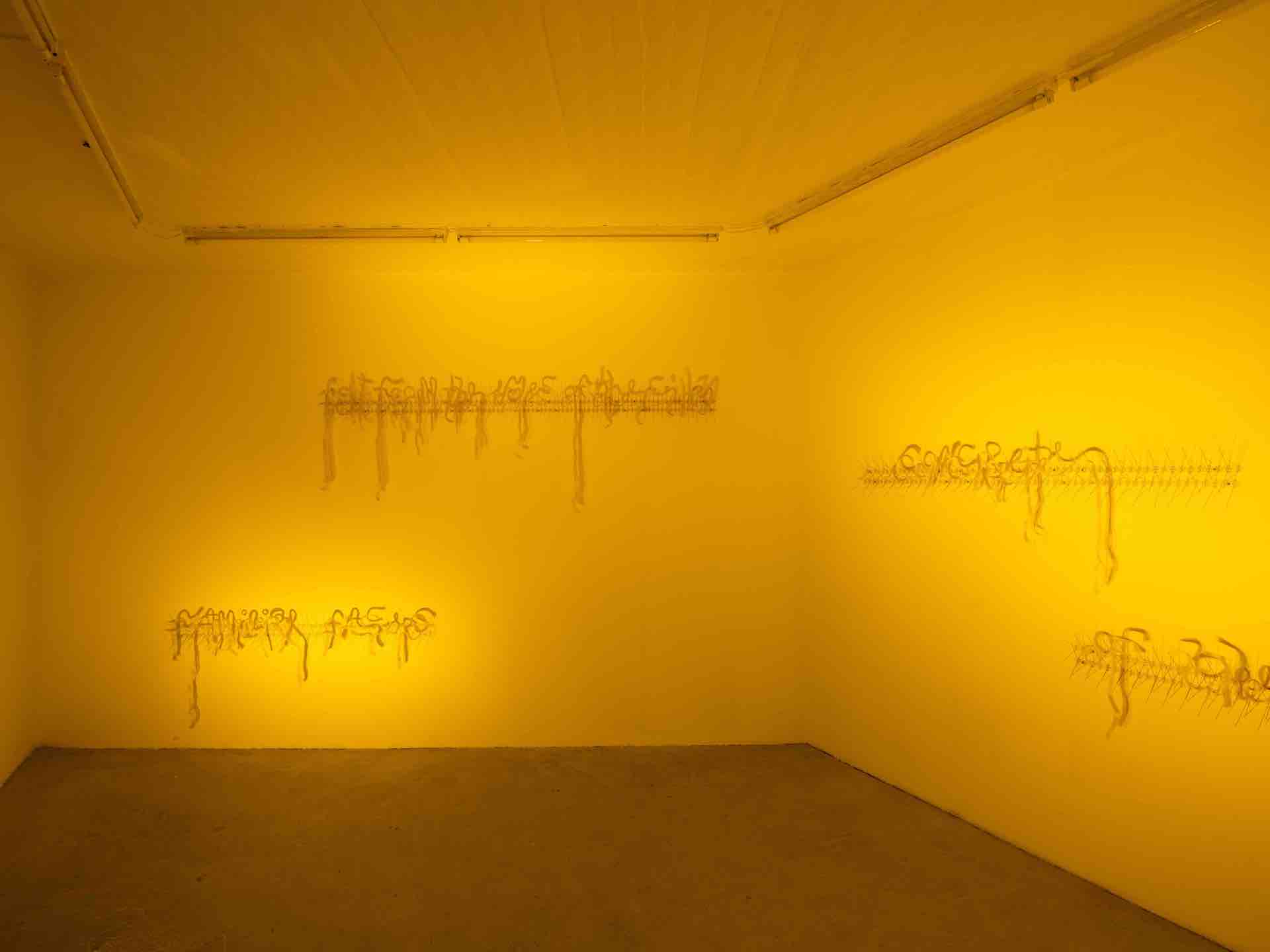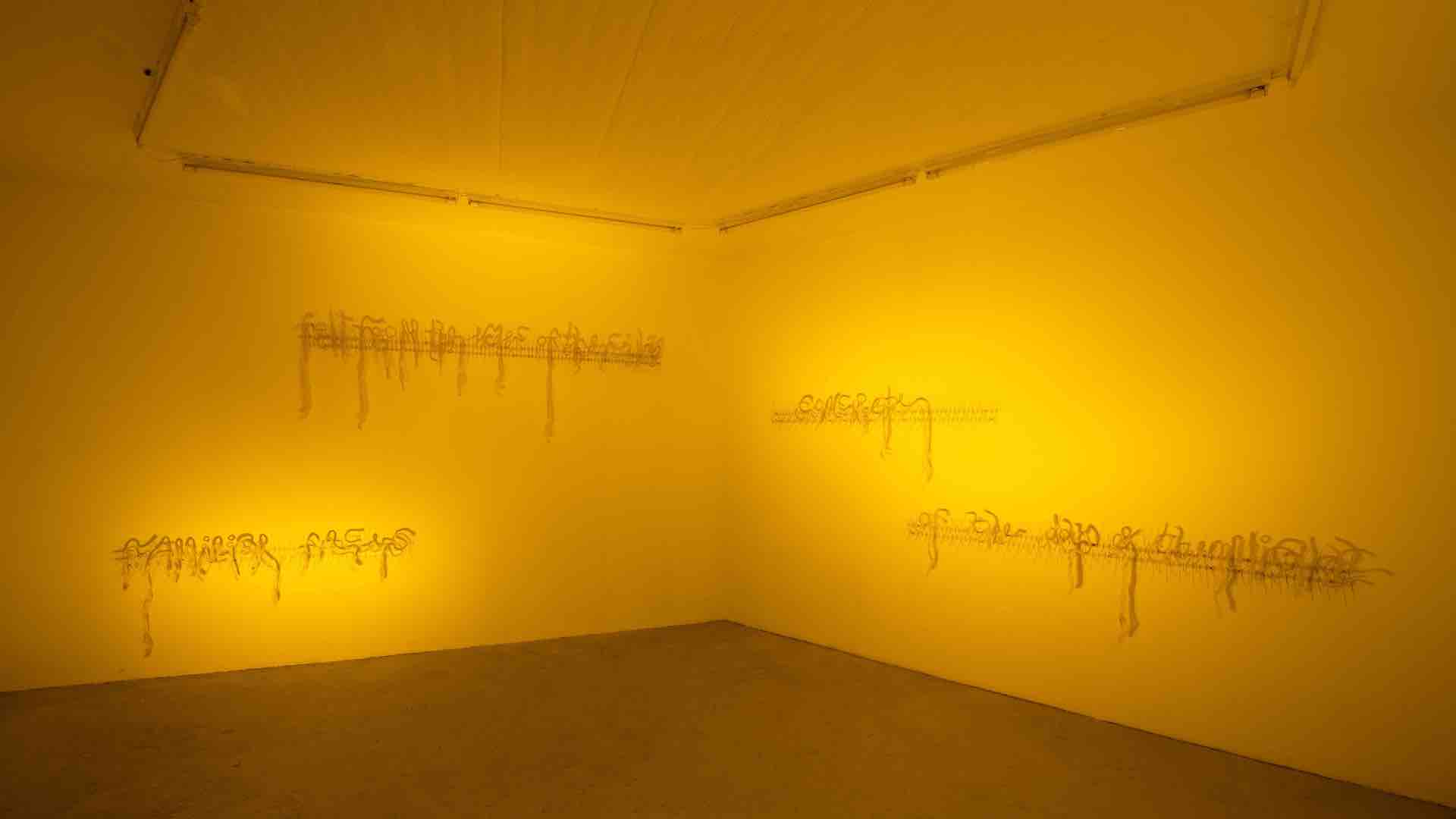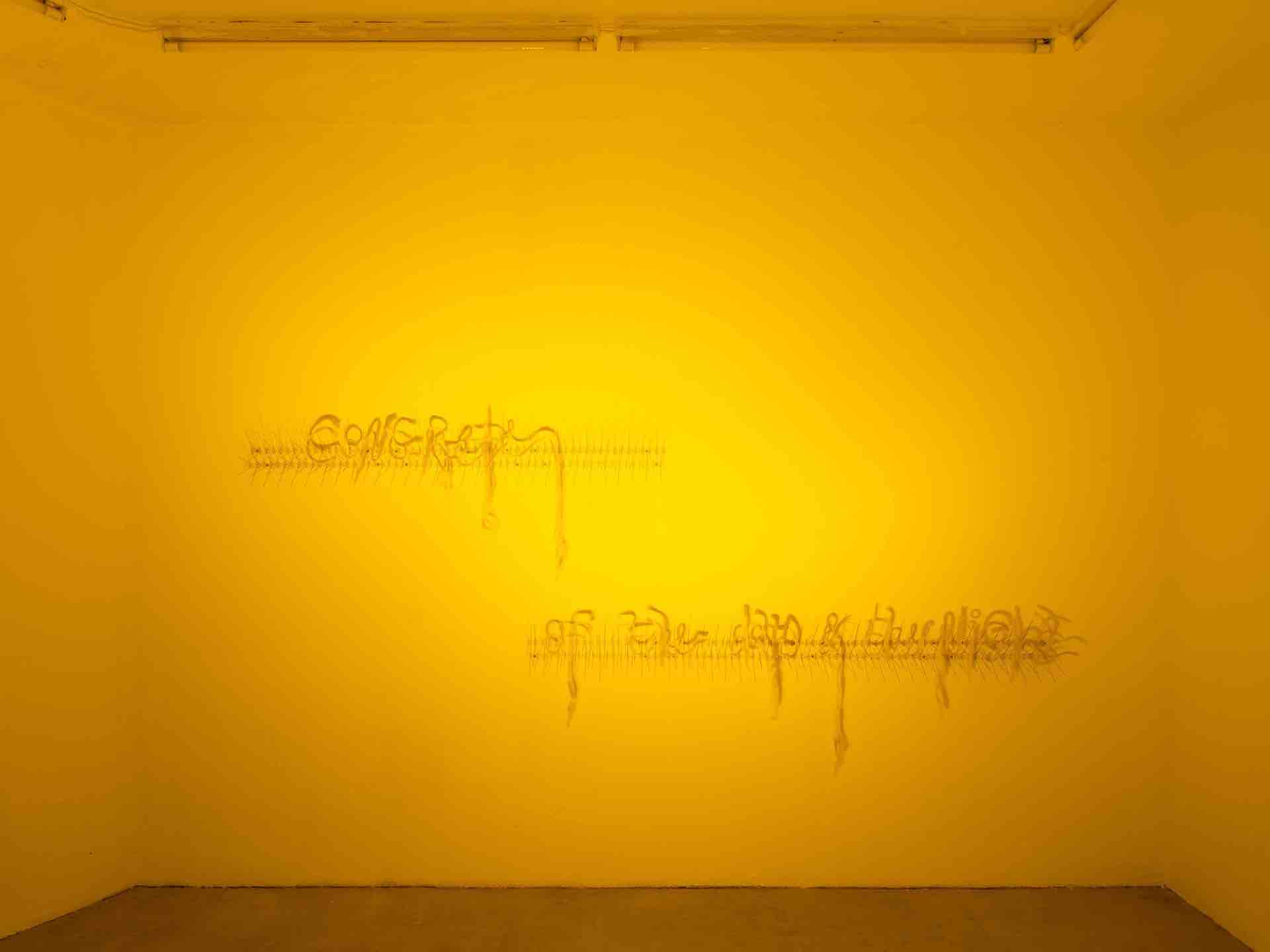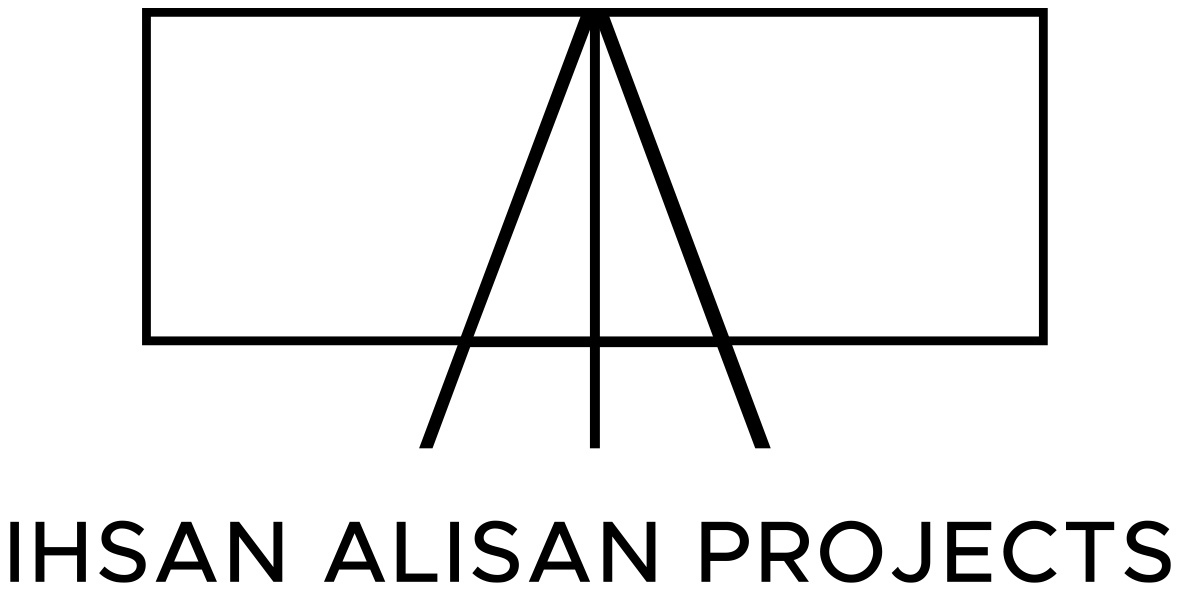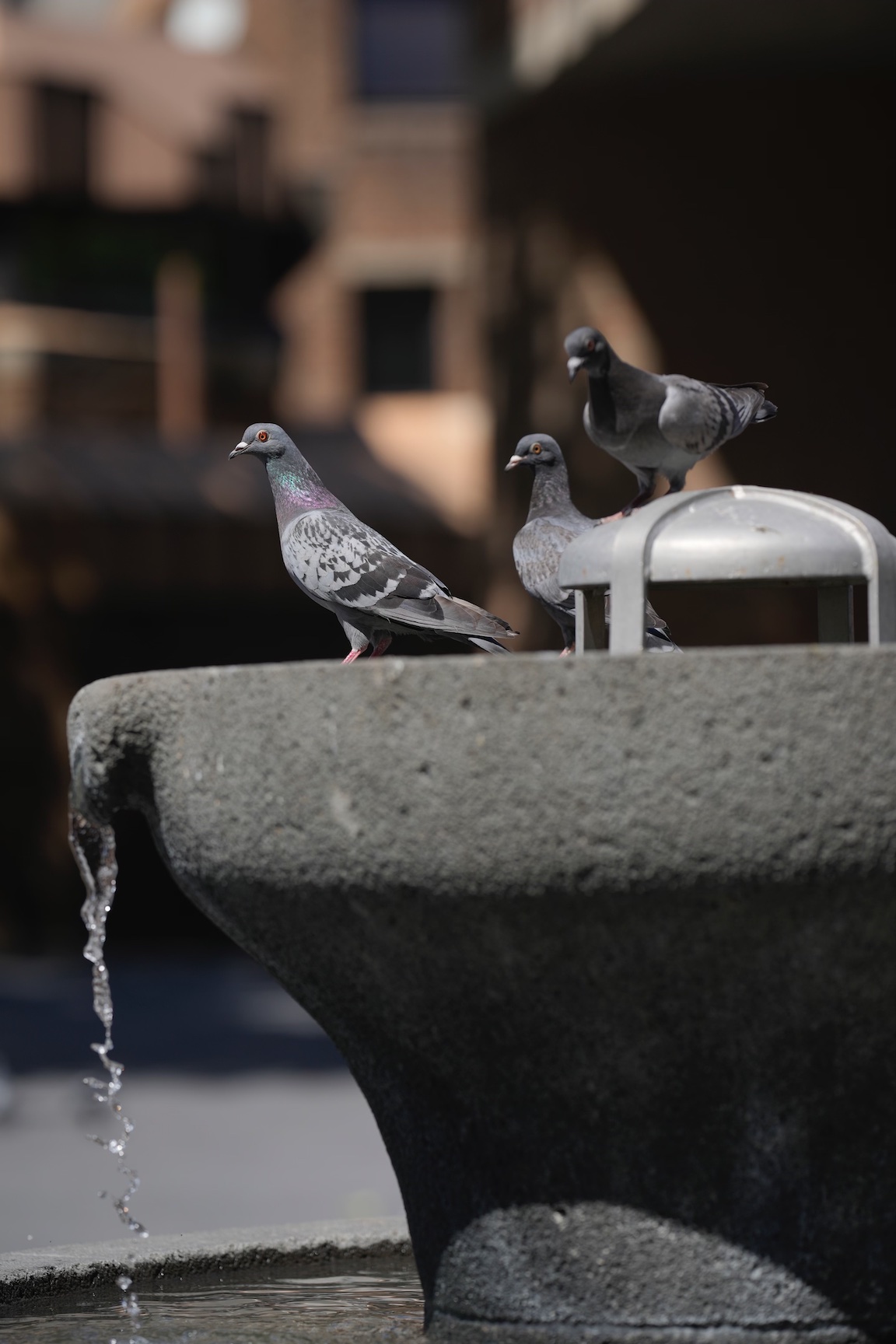
Photo Credit: Dirk Rose
AYHAM MAJID AGHA | REBEKKA BENZENBERG |
ANNA-MARIE BERDYCHOVÁ & SAMUEL STANO
And Then There Are the Pigeons ...
kuratiert von | curated by KATHARINA KLANG
02.09. – 08.10.2022
Eröffnung | Opening
01.09.2022 | 19 - 22 UHR | 7 - 10 PM
Erweiterte Öffnungszeiten zum DC‑Open Wochenende 02. — 04. September
Freitag 13 — 21 UHR | Samstag und Sonntag 13 — 20 UHR
Extended opening hours during DC‑Open Weekend September 02. — 04.
Friday 1 — 9 PM | Saturday and Sunday 1 - 8 PM
siehe auch | see also
/monopol.png)

english below
AND THEN THERE ARE THE PIGEONS...
Die künstlerischen Positionen der Gruppenausstellung And Then There Are the Pigeons... entwerfen Strategien der Inbesitznahme und Teilhabe entgegen einer Regulierung des öffentlichen Raums. Am Beispiel und lernend von Stadttauben sollen alternative Handlungs- und Widerstandsformen in künstlerische Praxis überführt und zu einer Auseinandersetzung über streitbare, geteilte Lebensräume gedacht werden.
“Tauben sind die letzten Punks“, dieser Satz ragt wie eine erhobene Faust seit sechs Jahren in meiner Erinnerung. Er stammt vom Wiener Künstler und Philosoph Fahim Amir, der damals einen Vortrag in der Kunstakademie Düsseldorf hielt und vom Widerstand des Lebendigen sprach. Über das Wahrnehmen von Tieren als politische Subjekte. Tierpraktiken können Identität und soziale Beziehungen strukturieren und widerspiegeln. Was sagt unsere Beziehung zu Tauben über unsere Gesellschaft aus und welche Handlungsalternativen können wir von ihnen und im Umgang mit ihnen lernen?
1966 erscheint im New Yorker ein Artikel von Thomas P. Holving, der über die städtische Verwahrlosung und über sogenannte ”verschmutzte“ Räume schreibt. Neben Müll, Vandalismus, Dealerei und Obdachlosigkeit verzeichnet er auch eine Vielzahl von Tauben. Mit dem Zusatz ”And Then There Are the Pigeons...“ beschreibt er unsere tierischen Mitbewohner:innen als störendes, unvereinbares Gegenüber, da es die Taube sei, die ”unseren Efeu frisst, unsere Blumen und eine Gesundheitsbedrohung darstellt.“1 Zusätzlich wird in diesem Text das Stigma der Ratten der Lüfte siegreich etabliert.
Dabei zählen Tauben jahrhundertelang zu treuen Begleiter:innen menschlicher Ansammlungen. Aufgrund ihrer Anpassungsfähigkeit, Sozialität und Reproduktionszyklen sind sie leicht zu domestizieren und fungieren als enge Vertraute des Menschen, Informationsüberbringerin, Unkrautvernichterin, Düngerproduzentin, Nahrungsquelle und als Prestigeobjekt.2 Bei kaum einem anderen Tier wird so stark klassifiziert wie bei der Taube. Das domestizierte weiße Exemplar steht als Friedenssymbol, für Göttlichkeit und als Heilsbringerin (dove), während das nicht-weiße Exemplar (pigeon), häufig obdachlos, im Status des ”forever foreigner“ verbleibt, was sie nach Fahim Amir zum ”Wappentier der Migration“3 macht. Diesen missverstandenen, heimatsuchenden Haustieren wird ihre Anpassungsfähigkeit und Treue vorgeworfen. Als Projektionsobjekte verweilen sie auf der Schwelle zwischen Haus- und Wildtier und erschüttern unsere Auffassung der Kategorie Natur innerhalb der Ordnung des Urbanen – von disziplinierten, sauberen Stadträumen.
In ihrer ”Widerspenstigkeit“ oder, je nach Lesart, cleveren Anpassungsfähigkeit, werden sie zu unruly creatures (Michel Foucault). Sie brüten trotz Abwehrsystemen, bauen Nester trotz glatter hochmodernisierter Fassaden und scheißen auf Kulturdenkmäler. Darüber hinaus ”stiften“ sie aufgrund ihrer sozialen Interaktionsfähigkeit noch zu Ordnungswidrigkeiten an. Nach der Kölner Stadtordnung besteht seit dem 29.1.2017 ein Taubenfütterungsverbot, welches das Füttern, Auslegen oder Anbieten von Futter für verwilderte Haustauben oder Wildtauben mit 35 bis 1.000 Euro ahndet – womöglich gibt es in vielen Städten keine verbreitetere Straftat als das Füttern von Tauben.
Anna-Marie Berdychová (*1994) interessiert sich für die Wandelbarkeit von Materialien und die Stadien ihrer Zersetzung. Mit gefundenen Objekten und DIY-Techniken nimmt sie den natürlichen Verfall vorweg. Samuel Stano (*1999) erforscht in seiner Arbeit symbolische Machtverhältnisse und die Politik des öffentlichen Raums. Beide lernten sich während ihres Studiums an der Akademie der Bildenden Künste Prag kennen und arbeiten seit 2021 zusammen. Der Logik des Nestbaus von Tauben folgend, haben sie für die Ausstellung nicht klassifizierte Vögel und Nester aus gefundenen und recycelten Materialien entworfen. Dabei kopieren sie eine natürliche Form der Inbesitznahme und hinterfragen, wem der städtische Raum gehört und wer gestalterisch, teils unbemerkt, auf ihn einwirkt.
Rebekka Benzenberg (*1990) studierte an der Kunstakademie Düsseldorf bei Rita McBride, Franka Hörnschemeyer und Ellen Gallagher. In ihren installativen Arbeiten verweist Rebekka Benzenberg auf binäre Machtstrukturen sowie auf physische Kontroll-, Konsum- und Disziplinierungsmechanismen. Das für die Ausstellung entwickelte Werk Eyes of the City besteht aus der Aneinanderreihung von sogenannten ”Taubenabwehrspikes“ oder ”Pestsystems“. Das Abwehrsystem, dass das Niederlassen von Tauben verhindern soll, wird hier zur Trägerin poetischer Zeilen (familiar faces | felt from the eyes of the city | concrete | of the day and the night | previous stories). In die herausragenden Spitzen installiert Benzenberg blonde Haarsträhnen und implantiert auf diese Weise eine Botschaft an das Kontrollsystem des öffentlichen Raums aus interspezifischen Perspektive und überschreibt somit seine Bedrohlichkeit.
Ayham Majid Agha (*1980) ist Theaterregisseur, Schauspieler und Taubenzüchter. Er ist Absolvent der renommierten Hochschule für Darstellende Künste in Damaskus, an der er von 2006 — 2012 als Junior-Professor tätig war. Von 2005 — 2012 war er Mitglied des Theaterstudios, das interaktive Theaterprojekte in syrischen Dörfern aufführte. Bevor Ayham Majid Agha 2013 Syrien verließ, spielten Tauben, wie in vielen Teilen der Welt, besonders der arabischen, aufgrund ihres Navigationstalent und ihrer Ortstreue, bereits eine zentrale gesellschaftliche Rolle. Er arbeitete am Gorki-Theater und gründete 2016 das Exile Ensemble sowie 2021 das Berliner Taubentheater im Atelier Gardens Berlin/ BUFA Studios. Das Taubentheater verfolgt einen interspezifischen Ansatz zwischen Tierschutz, Kunst und Wissenschaft. Aktuell arbeitet das Taubentheater an Die Hängenden Gärten der Oberlandstraße – ein Outdoor-Festival über Heimat, Stadtökologie und nachhaltige Formen des Zusammenlebens und befragt Komplexitäten die an Kategorien wie Heimat, Heimatland und Zugehö- rigkeit gekoppelt sind. Im Laufe dieses Projekts wird das tierische Ensemble des Taubentheaters mit GPS-Systemen und Kameras ausgestattet 573 km von Köln und anderen Städten nach Hause (Berlin) fliegen. Für And Then There Are the Pigeons... hat das Taubentheater eine prototypische Skizze eines Taubenturms angefertigt. Taubentürme sind von von Menschen entworfene Schutzräume für Tauben, die ideal auf ihre Bedürfnisse angepasst sind und besonders in arabisch sprachigen Ländern als architektonische Meisterwerke gelten. Mit einer liebevollen Handlungsanweisung für einen respektvollen Umgang mit Tauben führt das Taubentheater tief in das sensible Wesen der Tiere ein und formuliert einen deutlichen Aufruf zu vermehrter Toleranz und Respekt für unsere Mitwesen.
And Then There Are the Pigeons... ist vom 2.9. 2022 — 8.10.2022 am Ebertplatz bei Mouches Volantes zu sehen. Als Teil von Brunnen e.V., ein Zusammenschluss der Kunsträume und Mietparteien der Ebertplatzpassage, stellt er die kulturelle Nutzung des Platzes bis zum Umbau im Zuge des Masterplans sicher. Besonders im Kontext um die Nutzung des Ebertplatz können die dort ansässigen Bars, Menschen, Tiere und Kunsträume ebenfalls als unruly creatures in performativen Protestformen gegen die Ökonomisierung des öffentlichen Raumes und als Belebung des Ortes und als friedliche Revolutionär:innen gelesen werden.
Katharina Klang studierte Kunstgeschichte und Philosophie und ist freie Kuratorin für Gegenwartskunst sowie Gründungsdirektorin der Sammlung Philara, die sie von 2016 — 2022 leitete. Neben ihrer Arbeit als Autorin und Dozentin kuratierte sie zahlreiche Ausstellungen. Im Zentrum ihres Interesses steht die Auseinandersetzung mit Erinnerungskulturen, Archiven, Politiken des öffentlichen Raums, Mensch-Tier-Beziehungen sowie der Ethik des Sammelns.
1Amir, Fahim, Schwein und Zeit. Tiere, Politik, Revolte, Hamburg 2018.
2Cf. Schneider, Karin, Tauben, Berlin 2021.
3Amir, Fahim, Schwein und Zeit. Tiere, Politik, Revolte, Hamburg 2018.
english
AND THEN THERE ARE THE PIGEONS...
The artistic positions of the group exhibition And Then There Are the Pigeons... formulate strategies of appropriation and participation against a regulation of public space. Based on the behavior of urban pigeons, alternative forms of intervention and resistance are transferred into artistic practice and conceived as an engagement with contested, shared habi- tats.
“Pigeons are the last punks” this phrase in my memory like a raised fist for six years. It comes from the Viennese artist and philosopher Fahim Amir, who at the time gave a lecture at the Kunstakademie Düsseldorf and spoke of the resistance of the living. About the perception of animals and how their practices can structure and reflect identity and social relations. What does our relationship with pigeons say about our society and what alternative actions can we learn from them?
In 1966, an article by Thomas P. Holving appeared in the New Yorker, writing about neglected urban and so-called “polluted” spaces. In addition to trash, vandalism, dealing, and homelessness, he also lists a large number of pigeons. Adding the phrase “And Then There Are the Pigeons...” he describes our animal neighbors as a disturbing, incompatible counter- part, as it is the pigeon that “eats our ivy, our flowers, and poses a health threat.” 1 In addition, the stigma of the rats of the air is victoriously established in this text.
Yet pigeons have been among faithful companions of human settlements for centuries. Their adaptability, sociality, and reproductive cycles make them easy to domesticate and they serve as close confidants of humans, information transmitters, weeders, fertilizer producers, food sources, and prestige objects. 2 Few other animals are as highly classified as the pigeon. The domesticated white specimen stands as a symbol of peace, divinity, and salvation (dove), while the non-white specimen (pigeon), often homeless, remains in the status of “forever foreigner,” making it, according to Fahim Amir, the “heraldic animal of migration.” 3 These misunderstood, home-seeking pets are reproached for their adaptability and loyalty. As objects of projection, they linger on the threshold between domestic and wild animal, shaking our conception of the category of nature within the order of the urban – of disciplined, clean urban spaces.
In their “unruliness” or, depending on the reading, clever adaptability, they become unruly creatures (Michel Foucault). They breed despite defensive systems, build nests despite slick ultra-modernized facades, and shit on cultural monuments. In addition, they still “instigate” misdemeanors due to their social interaction ability. According to the Cologne city ordinance, there has been a pigeon feeding ban since Jan. 29, 2017, which penalizes feeding, laying out or offering food to feral domestic pigeons or wild pigeons with a fee of 35 to 1,000 euros - possibly there is no more common offense in many cities than feeding pigeons.
Anna-Marie Berdychová (b. 1994) is interested in the mutability of materials and the stages of their degradation. Using found objects and DIY techniques, she anticipates natural decay. Samuel Stano's (b. 1999) work explores symbolic power relations and the politics of public space. The two met while studying at the Academy of Fine Arts Prague and have been working together since 2021. Following the logic of pigeons building nests, they have designed unclassified birds and nests from found and recycled materials for the exhibition. In doing so, they copy a natural form of appropriation and question who owns urban space and who has a creative impact on it, sometimes unnoticed.
Rebekka Benzenberg (b. 1990) studied at the Kunstakademie Düsseldorf with Rita McBride, Franka Hörnschemeyer and Ellen Gallagher. In her installation works, Rebekka Benzenberg refers to binary power structures as well as physical mechanisms of control, consumption and discipline. The work developed for the exhibition, Eyes of the City, consists of the juxtaposition of so-called "pigeon defense spikes" or "pest systems." The defense system that is supposed to prevent the landing of pigeons becomes here the carrier of poetic lines (familiar faces | felt from the eyes of the city | concrete | of the day and the night | previous stories). Benzenberg installs strands of blond hair into the protruding tips and in this way implants a message to the control system of public space from an interspecific perspective and while overwriting it threats.
Ayham Majid Agha (b. 1980) is a theater director, actor and pigeon breeder. He is a graduate of the prestigious Damascus University of Performing Arts, where he worked as a 2006 - 2012 as a junior professor. From 2005 - 2012 he was a member of the theater studio, which performed interactive theater projects in Syrian villages. Before Ayham Majid Agha left Syria, pigeons, as in many parts of the world, especially Arab, already played a central social role due to their navigational talent and loyalty to place. He worked at the Gorki Theater and founded the Exile Ensemble in 2016 and the Berlin Pigeon Theater in 2021 at Atelier Gardens Berlin/ BUFA Studios. The Pigeon Theater takes an interspecific approach between animal welfare, art and science. Currently, the Pigeon Theater is working on The Hanging Gardens of Oberlandstraße - an outdoor festival about home, urban ecology and sustainable forms of coexistence, and interrogates complexities tied to categories such as home, homeland, and belonging. In the course of this project, the animal ensemble equipped with GPS systems and cameras, will fly 573 km from Cologne and other cities to their home (Berlin). For And Then There Are the Pigeons... the Pigeon Theater made a prototypical sketch of a pigeon tower. Pigeon towers are human-designed shelters for pigeons that are ideally suited to their needs and are considered architectural masterpieces, especially in Arabic cultures. With an affectionate instruction for a respectful treatment of pigeons , the Pigeon Theater introduces deeply into the sensitive nature of the animals and formulates a clear call for increased tolerance and respect for our fellow beings.
And Then There Are the Pigeons... can be seen from 2.9. 2022 to 8.10.2022 at Ebertplatz at Mouches Volantes. As part of Brunnen e.V., an association of the art spaces and tenants of the Ebertplatzpassage, it ensures the cultural use of the square until the reconstruction in the course of the master plan. Especially in the context of the use of Ebertplatz, the bars, people, animals and art spaces located there can also be read as unruly creatures in performative forms of protest against the economization of public space, as gentle revolutionaries, and as a revitalization of the place.
Katharina Klang studied art history and philosophy and is a freelance curator of contemporary art as well as the founding director of the Philara Collection, which she managed from 2016 - 2022. In addition to her work as an author and lecturer, she has curated numerous exhibitions. Her interests focus on memory cultures, archives, politics of public space, human-animal relations, and the ethics of collecting.
1Amir, Fahim, Schwein und Zeit. Tiere, Politik, Revolte, Hamburg 2018.
2Cf. Schneider, Karin, Tauben, Berlin 2021.
3Amir, Fahim, Schwein und Zeit. Tiere, Politik, Revolte, Hamburg 2018.
Gefördert von | With support of:

english below
Tauben sind Lebewesen, bei denen jedes Mitglied der Gruppe in seinem Wesen und seiner Persönlichkeit einzigartig ist. Es gibt Dinge, die ihnen Angst machen, es gibt Dinge, in die sie sich verlieben und es gibt viele Dinge, die sie anderen vorziehen.
Ob man nun ein Fan von Tauben ist oder lieber keine Freundschaft mit Tauben schliessen möchte, ist eine persönliche Entscheidung.
Gleichwohl, für die Tauben gilt Folgendes:
— Tauben haben ein sehr gutes Gedächtnis. Wenn man sie mit Freundlichkeit und Liebe behandelt, werden sie sich sicher daran erinnern und immer versuchen, in deiner Nähe zu sein, denn das gibt ihnen ein Gefühl von Sicherheit.
— Tauben mögen keine plötzlichen und heftigen Bewegungen und auch keine lauten Geräusche und Schreie. Das macht sie nervös und unruhig.
— Tauben bevorzugen es, ihre Nester auf Bäumen und an ruhigen Orten zu bauen, aber sie sind gezwungen, auf Balkonen, Ladenschildern und Straßenampeln zu leben, weil ihr menschlicher Freund mehr als 70 % der Stadtbäume, die ihr Zuhause waren, gefällt hat.
— Brot wird aus Weizen hergestellt, aber es enthält auch Hefe, die dem Magen und der Gesundheit der Tauben schadet. Versuche also immer anderen zu raten, Tauben nicht mit Brot zu füttern, sondern nur mit Getreidesamen.
— Man ist nicht verpflichtet, Tauben zu lieben, aber man sollte sie nicht verletzen oder sie mit Spitz- namen diffamieren, die ihrer Existenz schaden, wie: die Ratten der Lüfte, Dreckstauben oder sie als hässliche Wesen bezeichnen oder mit anderen ähnlichen Eigenschaften assoziieren.
— Die Taube ist das erste Wesen, das eine Beziehung zu unseren Vorfahren aufbaute und sie nie verletzt hat. Vielmehr halfen sie ihnen, die Laufrichtungen ihrer Routen zu entdecken, Briefe und Medizin zu transportieren, Quellen für sauberes Wasser und Nahrung zu finden. Sie halfen ihnen eine angenehme Zeit zu verbringen.
— Es gibt bestimmte Stunden, in denen Ausgebildete die Tauben täglich füttern. Wenn du ihnen dabei zusehen oder helfen möchtest, kannst du dich nach den Terminen und Einzelheiten erkundigen und mitmachen.
— Tauben sind starke, mutige und großzügige Geschöpfe, die ihr Glück gerne mit anderen teilen.
Beraube sie nicht ihrer Freude, wie andere sie ihrer natürlichen Lebensräume beraubt haben.
Das Taubentheater, Berlin
english
Pigeons are creatures in which each member of the group is unique in its nature and personality. There are things that scare them, there are things that make them fall in love, and there are many things that it prefers over others.
If you are someone, who is a fan of pigeons, or someone who prefers not to establish a friendship with pigeons; this is a personal decision.
However, for the pigeons:
— Pigeons have a very strong memory. If you treat them with kindness and love, they will certainly remember that and they will always try to be near you, as this gives them a sense of security.
— Pigeons do not like sudden and violent movements, nor loud sounds and screaming, this makes them tense and uncomfortable.
— Pigeons prefer to build their nests on trees and in quiet places, but they are forced to live on balconies, shop signs, and street traffic lights, because their human friend has cut down more than 70% of the city trees that were their homes.
— Bread is made of wheat and this is true, but it also contains yeast that harms the stomach and health of pigeons. So, always try to advise others not to feed pigeons bread, but only grain seeds.
— You are not obligated to love pigeons, but you should not hurt them or bully them with nicknames that harm their existence, such as: the sky rats, the dirty pigeons, or the ugly beings and other likewise characteristics.
— The pigeon is the first being that established a relationship with our ancestors and never hurt them once. Rather, they helped them in discovering the directions of their routes, carrying letters and medicine, finding sources of clean water and food, and helped them to spend their time in happiness living together.
— There are specific hours that professionals feed the pigeons on a daily basis. If you want to watch or help them, you can ask about the dates and the details, and participate if it’s possible.
— Pigeons are strong, brave, generous creatures and love to share their happiness with others.
Do not deprive them of their joy as others have deprived them of their natural living places.
The Pigeon Theatre, Berlin
